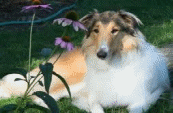Animal Assisted Therapy
Animal assisted therapy, abbreviated as AAT entails the utilization of animals that have been therapy certified to be part of the healing strategy. According to a description by Delta Society, animal assisted therapy is an important component of treatment for different individuals and groups who appear to be cognitively, emotionally, socially or physically challenged. People found in the nursing homes or hospitals particularly the elderly and children normally benefit from the use AAT.
Whereas animals namely kittens and stallions having been making exceptional therapy animals, it is clear that dogs are beyond doubt the best and common type of therapy faunae. This might be attributed to the inimitable bond which is shared between humans and canines (Thompson, 2009). Truly, therapy dogs have proved to be making a significant change in the lives of individuals they happen to encounter.
The history of Animal Assisted Therapy
Even though it looks current and new age, animal assisted therapy or pet therapy can trace back its historical roots to Belgium in the nineteenth century. During this period, farm animals mostly those located within the Belgium town were considered to be an imperative component of therapy for the disabled home-based people.
This implies that animals particularly the dogs have incessantly assisted human beings to recover from various mental illnesses since time in memorial. In fact, dogs have lifted human beings spirits, offered them companionship and helped them in working (Thompson, 2009). Nevertheless, in the twentieth century, animals became legitimately acknowledged for their respective therapeutic aptitudes.
Elaine Smith in the fiscal 1976 was the first person to establish the initial therapy dogs’ registry in the US called Therapy Dogs international. A year later, the currently known Delta Society was formed under the name Delta Foundation. This foundation was mandated to investigate the impacts that animals had on individuals’ lives (Prothman, Bienert & Ettrich, 2006). Currently, the two groups together with various others have assisted in the provision of therapy animals to individuals who require animal assisted therapy.
Legal and ethical issues in AAT
Therapy dogs are often selected as puppies founded on their training receptiveness and disposition testing. The breed of dog selected should suit the work it is envisioned to accomplish implying that therapy dogs should contentedly fit into the life of a therapist. If a dog is deemed a fabulous pet it is not true that it will definitely be an operative canine psychotherapist.
Ethical attributes needs to be taken into consideration (Halm, 2008). The preferred traits include: the dog can easily calm itself, lacking hostile tendencies, possess high level of frustration tolerance, well socialized, cope well with other canines and desire to constantly be with beings.
Dogs that do not enjoy interacting with human beings and those that do not have a gamut of actions and tricks must not be chosen. Therapy dogs must adore creating contacts with beings in order to be groomed and petted. However, the chosen dogs must be accustomed to the therapy surrounding environment and must positively respond to what the client requires (VanFleet, 2008). Since there are dogs of various ages, sizes and breeds, therapy dogs must be non-aggressive and social.
After a therapy dog is selected, it should be given the primary obedience training. To realize this, training of the therapy dogs must be handled by competent counselor and trained pet handlers. The training needs to gyrate around fun, praise and positive reinforcement (Shelton, Leeman & O’Hara, 2011).
The training and certification of therapy dogs needs to be done and approved by recognized agencies. Since there are global AAT certification programs, therapists who want to use therapy dogs in their psychotherapy work should ensure that the dogs certified to be used in the treatment sessions.
Agencies that promote therapy dogs training and certification
Delta Society registers and certifies pets which offer animal assisted therapy. Delta Society recommends that any dog that is to be used in animal assisted therapy must exhibit obedience by successfully finishing the testing and training program (Delta Society, 2006).
The certifications with Therapy Dogs International (TDI) necessitate that therapy dogs and their trainers must pass the primary Therapy Dogs Test, the Canine Good Citizen as well as the obedience class.
The certification further requires the dog handlers to reach an agreement that they will aptly follow the Delta Society standards while maintaining the annual vaccination and health records. Therapy dog handlers are required by TDI to annually renew their membership cards including routine checkups, current vaccinations and yearly veterinary visits (Thompson, 2009).
Suitable therapy dogs’ profile
Breed: Therapy dogs maybe of any breed, but attributable to the overall temperament traits, other breeds are considered to be more suitable. Examples of the most popular therapy dogs include collies, greyhounds, Newfoundland and retrievers. Some dogs are always too timid, protective or aloof, yet it is important to consider an individual dog. Here are examples of therapy dogs breeds:


Retrievers

Coolies
Size and age: Therapy dogs can take any size ranging from giants to toys. Particular concern should be given clients who could fear larger dogs. Toy breed therapy dogs needs gentle handling.

In fact, therapy dogs needs to be at least one-year old and should be allowed to continue provided the dog is mentally and physically able.

Uno the beagle
Health status and temperament: Therapy dogs must be well groomed, clean, updated on heartworm exams, negative fecal and vaccination. They need to be of good physical health including free of ear and eye discharge and have their nails clipped. Therapy dogs must not be aggressive, must have tolerant temperament and stable. They need to have interests in individuals and outgoing in nature. See picture below for corgi:

Approaches of incorporating therapy dogs into therapeutic sessions
When a mental health professional intends to bring dog into a therapeutic session, there are a number of factors that must be put into consideration. First, the therapist must set the goals that are allied to the utilization of the therapy dog and this should be done for each client. Secondly, the psychotherapist needs to determine the frequency on how the therapy dog should be used (Phillips, 2003). The therapy dog’s presence might not be important for all therapeutic play sessions.
For example, there might be certain kids who actively react to the therapy dogs’ usage in each and every session while other kids may fancy using dogs occasionally. In non-directed play psychotherapy, it might be supportive for the therapist to incorporate the therapy dog in each session given that this kind of therapy requires maintaining some continuity, certainty and constancy in the therapeutic play sessions (Thompson, 2009). Here is picture of a dog used in therapeutic sessions:

Pugs
In directed psychoanalysis, therapy dogs might occasionally be utilized to respond to a kid’s therapeutic goals and objectives. Third, the health professional must consider the stress and energy levels of the therapy dogs since it might limit the dogs’ usage in different treatment sessions (Sockingam & Li, 2008).
When it becomes apparent that the therapy dog is frazzled, worn-out or detached, such a dog’s usage might not be considered therapeutic any more. It is of great significance to permit therapy dogs to quit therapeutic sessions if they display signs of worry or anxiety (Thompson, 2009). This could equally be considered as an imperative modeling session for children.
Goals of dog therapy
VanFleet and Thompson (2009) in their study highlighted the following as the major goals and intentions of integrating dogs into patient or clients treatment sessions:
- To uphold the expressions of children or patients feelings and enhance their self esteems
- To develop the patients care giving, sharing and empathetic capabilities
- To assist in the quick establishment of rapports and capitalize on the ordinary interest that patients such as kids and adults tend to have in faunae
- To provide nurturance via presenting to the clients the unconditional interactions and acceptance
- To improve on the children’s confidence levels and social skills whereas decreasing their maladaptive and aggressive behaviors
- To provide the children and adults with the sole opportunity of overcoming the fear they might have in dogs
- To foster the patients healthy attachment affiliations not just with faunae such as dogs but also with people
- To help patients particularly the kids to share their shocking experiences in a passionately harmless manner, and;
- To assist in the improvement of problem solving and cooperation capabilities
In psychotherapy, animals such as dogs might be used in various ways to help psychotherapists meet these goals. However, very few methodical techniques have been acknowledged. For instance, some health professionals such as nurses and clinicians have used the dogs’ presence during patients’ treatment sessions to simply moderate anxiety. Other psychotherapy professionals have more actively used dogs together with other animals as co-therapists, in allegorical storytelling and role plays.
A further category of psychotherapists have seen animals like dogs as an opportunity for kids and other patients to unveil their controls for instance through obedience training (Kottman, 2001). This last category uses dogs as diagnostic tools to solicit children’s ability to link with other living things, their abilities to emotionally self-regulate, their aggressive tendencies and social skills.
Benefits of therapy dogs in counseling sessions
Animal assisted therapy as an important method of intervention entails introducing an animal such as a dog in the immediate surroundings of a patient or client with some therapeutic intentions. Recent research studies have revealed that AAT proffers innumerable benefits that surpass those that can be offered by customary therapies (Landreth, 2002).
Indeed, animal assisted therapy is not a therapeutic style like the rational emotive theory or the cognitive behavioral theory. This is because therapists have the chance to integrate the dog in any professional therapeutic style that has already been enacted by the therapists.
Often, the presence of a dog in therapeutic treatments is seen to develop and enhance trust building links amid clients and therapists. If a dog is integrated in healing sessions, it customarily releases the therapeutic angsts and pressures and the relations with such an animal emerge to be exciting, gratifying and very humorous. Through interacting with dogs, clients or patients may be helped to focus on issues that are perceived to be difficult since dogs aid in bringing the ability of the clients to be in touch with the allied state of mind.
In fact, when patients’ feelings are shared with therapy dogs, the dogs may prompt the emotive sharing course with the psychotherapists (White &Allers, 1994). For the patients, the dogs are observed as allies and friends, therefore they present a harmless environment to share emotions. Dogs thus provide nurturance by presenting the unrestricted acceptance.
To realize the positive results of using therapy dogs, Chandler (2005) identified various key techniques of administering AAT. These included:
- Allowing the clients to hug, touch and pet the therapy dog when the desire or need arises
- Drawing on the therapy dog as a co-therapist so as to summarize, clarify, paraphrase and reflect on the expressions and actions of the client, therapy dog as well as the relationships amid them
- Use therapy dog to develop and improve on the therapeutic association quality
- Using therapy dogs to offer access to the clients emotions
The value of AAT in the mental health field
To enhance therapeutic experience, animal assisted therapy with dogs has always been integrated with the play therapy to form the canine assisted play therapy also abbreviated CAPT. This type of therapy involves the inclusion of therapy dogs into the play therapy sessions so as to upsurge the quantity of chances that could be used to reflect feelings and track behaviors.
A therapy dog functions as co-therapist in therapeutic sessions whereby it engages the relaxing influences of the play (Thompson, 2009). Psychotherapist and dogs usually engage clients via the non-directed and directed play therapy. The main intention is to improve the emotional health of the clients especially the children.
Studies on dog assisted therapy
A research was conducted by Thompson, Weaver and Mustaine (2008) on the usage of dogs in the non-directive play therapy. The study method united both qualitative and quantitative techniques to investigate the variances in kids’ actions in the absence and presence of trained therapy dogs. Both negative and positive behavioral results were yielded by the gathered quantitative data. However, the qualitative data were derived from the general therapist narratives.
Study results indicated that there was a considerable effect on the response of the kids to play psychotherapy when therapy dogs were incorporated. For example, kids freely established rapport, portrayed improved knack to participate in thematic play and had enhanced affect and moods. Moreover, kids demonstrated a reduction in play distractions and destructive behaviors.
Further research studies have showed that animals play an integral part in the general growth of children. While in the company of animals, kids tend to learn about their social responsibilities, emotional reciprocities, boundaries and interactions.
Studies have further revealed that children and adults who own pets particularly dogs, cats and horses have better social skills, higher self-esteem and are more empathetic for others than other kids. According to Jalongo, Astorinno and Bomboy (2004) assertions, the animal to child bond seems to be very strong and it is different from any other kind of connection that children may encounter.
Gonski (1985) reviewed the issues of kids and the aged who had behavioral and emotional problems and reported that such children and old age groups had positive response towards animals.
In an analogous study of the ill-treated and abandoned kids in the short-term care, Gonski (1985) found that the ordinary company a dog was enough to elicit laughter, create excitements and lively conversation amongst children and the aged who materialized to be generally resistant, hostile and withdrawn. Such findings have formed the basis for instituting animals’ particularly the canines into therapeutic treatments.
Conclusion
Animal assisted therapy has proved to have the capacity to potentially mediate and successfully intervene for patients only when appropriate steps are assumed. Nevertheless, it is deemed imperative for psychotherapists to have some strong grounds in the play therapy prior to attempting to add therapeutic play dogs to the patients’ treatment sessions or children playrooms.
Furthermore, it is of great essence for psychotherapists to hand choose their preferred therapy dogs for temperament and personalities in order to make sure that the selected dogs have the correct certification and training regarded essential for their works. Above all, researches done on compelling counseling intervention have revealed that dogs are wonderful companions, friends and teachers. Currently, dogs appear to play a significant as wonderful therapists.
References
Chandler, C. K. (2005). Animal assisted therapy in counseling. New York: Routledge.
Delta Society (2006). Improving human health through therapy, service and companion animals. Web.
Gonski, Y. A. (1985). The therapeutic utilization of canines in a child welfare setting. Child and Adolescent Social Work Journal, 2, 93-105.
Halm, M. A. (2008). The healing power of the human-animal connection. American Journal of Critical Care, 17(4), 373-376.
Jalongo, M. R., Astorino, T., & Bomboy, N. (2004). Canine visitors: The influence of therapy dogs on young children’s learning and well-being in classrooms and hospitals. Early Childhood Education Journal, 32(1).
Kottman, T. (2001). Play therapy: Basics and beyond. Alexandria, VA: American Counseling Association.
Landreth, G. L. (2002). Play therapy: The art of the relationship. New York: Brunner-Routledge.
Phillips, D. (2003). Research and reflection: Animal-assisted therapy in mental health settings. Counseling and Values, 48, 47-56.
Prothman, A., Bienert, M., & Ettrich, C. (2006). Dogs in child psychotherapy: Effects on state of mind. Anthrozoos, 19(3), 265-277.
Shelton, L. S., Leeman, M. & O’Hara, C. (2011). Introduction to animal assisted therapy in counseling. Web.
Sockingam, S., & Li, M. (2008). Use of animal-assisted therapy in the rehabilitation of an assault victim with a concurrent mood disorder. Issues in Mental Health Nursing, 29, 73-84.
Thompson, M. J. (2009). Animal assisted play therapy: Canines as co-therapists. Compelling Counseling Intervention, 199-209.
Thompson, M., Weaver, A. & Mustaine, B. (2008). Effects of a trained therapy dog in child centered play therapy on children with anxiety disorders: Unpublished doctoral dissertation (Thompson). Sarasota, FL: Argosy University.
VanFleet, R. & Thompson, M. (2008). The power of cross-species play: Theory, research, and practice of canine-assisted play therapy. Paper presented at the annual conference of the International Society for Anthropology, Toronto, Canada.
VanFleet, R. (2008). Play therapy with kids & canines: Benefits for children’s developmental and psychosocial health. Sarasota, FL: Professional Resource Press.
White, J., &Allers, C. T. (1994). Play therapy with abused children: A review of the literature. Journal of Counseling & Development, 72, 390-394.